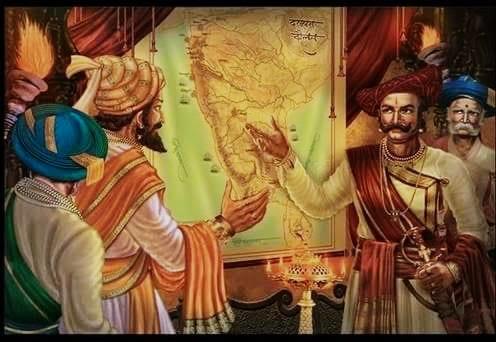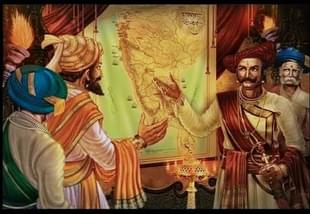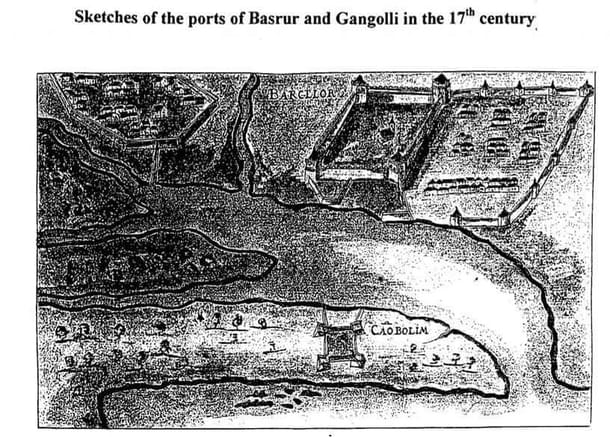Culture
Celebrating Shivaji’s First And Only Naval Expedition: Recapturing Indic Imagination, Recreating History One Anniversary At A Time
Harsha Bhat
Feb 12, 2021, 03:42 PM | Updated 03:42 PM IST
Save & read from anywhere!
Bookmark stories for easy access on any device or the Swarajya app.


Basrur is a tiny port town in Kundapur taluk of Udupi district in Karnataka. It finds mention in the works of various historical scholars and chroniclers as Barcelor, Barcalor, Basnur, Bares, Abu-Sarur and Barsellor.
But the town was relegated to the pages of history with the once bustling trade hub losing its sheen with time. However, the seeds of nationalism started sprouting in its soil once again during the last decade, and it is now slowly trying to regain its past glory.
Little did I know the last time I wrote a story on this tiny port town of Karnataka that I would witness history repeat itself. But as we celebrate tomorrow (13 February) yet another anniversary of the first naval expedition of the unmatched warrior of swarajya, Chhatrapati Shivaji Maharaj, to Basrur it sinks in that the parallels in time are one too many.
Way back in 1665, during the reign of the Adil Shah, the Nayakas of Keladi in Basrur were said to have written to Shivaji Maharaj to liberate their trade and markets from the clutches of the Portuguese.
Now, after three and a half centuries, the locals of Basrur are looking for help from historical researchers in Maharashtra to reclaim the glory of the port town from those who left it lost in time, and devoid of character.
Organisations led by locals of the town along with researchers and nationalist organisations from Maharashtra are working to re-establish this town as an important landmark in India’s glorious history and as a key town in the timeline of Hindu Hruday Samrat, Shivaji Maharaj.
Like how Shivaji deployed his naval force in this town, researchers like Sandeep Mahind of the Shivaji Samshodhana Kendra, who have devoted their lives to the cause of the vision and ideas of Chatrapathi Shivaji, organised a bike rally four years ago to this port town to mark the anniversary of the first naval expedition of Shivaji.
Today, in the fifth year of the anniversary, the town is gearing to host much more than just a token celebration. While it will mark the 356th anniversary of Shivaji’s first naval expedition to the town with an unveiling of the statue of the legendary ruler, it is also attempting to work towards reinstating the legend of the town and its tales in the timeline of the nation’s history.
While foreign historians recorded it as an ‘attack’ on Basrur by Shivaji who ‘plundered’ the port town, they conveniently buried the purpose of his arrival there. The streets of this tiny port town in Karnataka today bear names that are a testimony to the bustling trade town it once was and the organised town planning that facilitated the activities.
Once upon a time, Basrur stood as one of the most priced port towns that was wrested from the trade fiefdom of the Portuguese by Shivaji at the request of the Keladi Nayakas, and turned into a landmark of his first naval conquest ever.
It was the only place he took out a naval expedition to and returned after paying his respects at the Gokarna shrine, while restoring the trade and the town to the locals.
“Our tiny town despite being historically so eminent and strategically crucial, its history being so rich, its streets still stand testimony to all that it held in the past, has only found mention in passing in books documenting history of the region and apart from one work in Kannada isn’t given the attention it deserves. But every nook every corner has something to tell,” says Pradeep Kumar Basruru.
He is now working to document the available evidence, trace the missing ones and retell the tale of Basrur. Shetty put together six teams of youngsters in the region who are working to compile a work that will showcase the history and heritage of Basrur.

After Shivaji’s conquest, the local rulers got the upper hand and could dictate the rules of trade, which until then was monopolised by the Portuguese.
“Foreign historians say Shivaji Maharaj came to capture Basrur. Maharaj’s reign at that time was till Ponda. From there upto Basrur, the whole region was in the grip of either the British or Adil Shah. Even if he would jump this entire stretch and capture the sole port town, for how long would he hold it? If Basrur, Gangoli, Honnavar were to fall into trouble, Shivaji Maharaj would never be able to help them. Which is why when the advocate of the rulers of Bednur, the Keladi Nayakas, approached him to free it from the Portuguese, he seeks his aid so they could keep the region free from the trade clutches of the foreigners,” explains Mahind.
“A letter, dated 30 March 1665, that Shivaji Maharaj then wrote has him writing to the rulers of Bednur saying, the port town has now been taken back from the hands of the Portuguese and asks him to send his army and take control of the town,” explains Mahind.
Shivaji Maharaj left from Sindhudurg on 8 February landed in Basrur on 13 February, and on 14 February left the town by road, taking control of Gangoli, Honnavar and Bhatkal and then headed to Gokarna to visit the Shiva temple from where he writes the letter.
After the letter, Somashekhar, the son of Bhadrappa Nayak, who took the reins of the region, even paid Shivaji a large sum of money as a token of appreciation, or call it the war fee for freeing them from the clutches of the Portuguese traders.
There were two objectives that were achieved with this conquest. First, to defeat the foreign traders with the help of the locals, free the market from the grip of these traders and to return it to the locals. Two, to take revenge on the Portuguese for keeping captive the advocate of Shivaji.
“To help a fellow Hindu ruler gain hold over his Hindu kingdom and to check the hold of the foreign traders was important for the larger vision of a Hindu rashtra that Shivaji saw. In this direction, he did what he could to help them preserve their sovereignty and strengthen their kingdoms,” explains Mahind.
In parallel, the work to reclaim the narrative is also aimed at a similar purpose, say those behind these celebrations. “To establish confidence and faith in the minds of the locals and awaken in them a spirit of nationalism by rekindling in them pride about what is essentially their own heritage”.
While popular tales have tried painting the expedition as a tale of loot, a Kannada work titled “Hesaraada Pattana Basruru – Ondu Adhyayana” (Famous Town of Basruru – a Study) describes that the intent and purpose of the conquest was to diminish the forces of the Portuguese and the Dutch, and that it proved the power of his navy.
Its impact is documented in the book as one that broke the monopoly of the foreign traders and forced them to have better relations with the Keladi rulers.
“Shivaji’s Basrur naval expedition broke the monopoly of the foreign traders. After this event, the foreign traders carried on trade in association/friendly relations with the Keladi rulers”.
For those who seek to know what followed the raid, Shivaji, The Great Maratha by A H Sardesai, clarifies how local rulers neither resisted the raid nor was there any change in the political and economic scenario of the town after the raid, and how the town continued to be a major trade centre even after Shivaji left.
To quote the words of the Dutch, who describe the aftermath of the expedition, as quoted in the book Chatrapathi Shivaji Maharaj by V C Bendre, “Siwasi is very much loved and honoured here” – to this day.
While the town prepares to host its annual celebration tomorrow, it will also host a national level event by Yuva Brigade led by orator, activist Chakravarthi Sulibele chaired by Bharatiya Janata Party’s national general secretary B L Santosh and Shri Vishwaprasanna Teertha Swamiji of the Pejawar Mutt.
The event involves a bike rally with thousands of youth descending on this tiny town from three different corners of the state to symbolically reinstate its historic glory. The invite to the programme that will be held on on February 21, says the expedition anniversary event is an occasion to celebrate and cherish the special bond between the Kannada land and Shivaji Maharaj.
Efforts are on to re-establish the town as a bustling port hub, with many hoping to see a centre for maritime or naval studies set up here.
There are plans to hold a symbolic journey by sea as part of the anniversary celebrations involving the descendants of the legendary Maratha ruler, and to document the forgotten and buried historical milestones of a town that would otherwise remain consigned to the pages of history.
Harsha Bhat is an author, linguist, content strategist, and a compulsive chronicler of Bharat's civilisational heartbeat.





